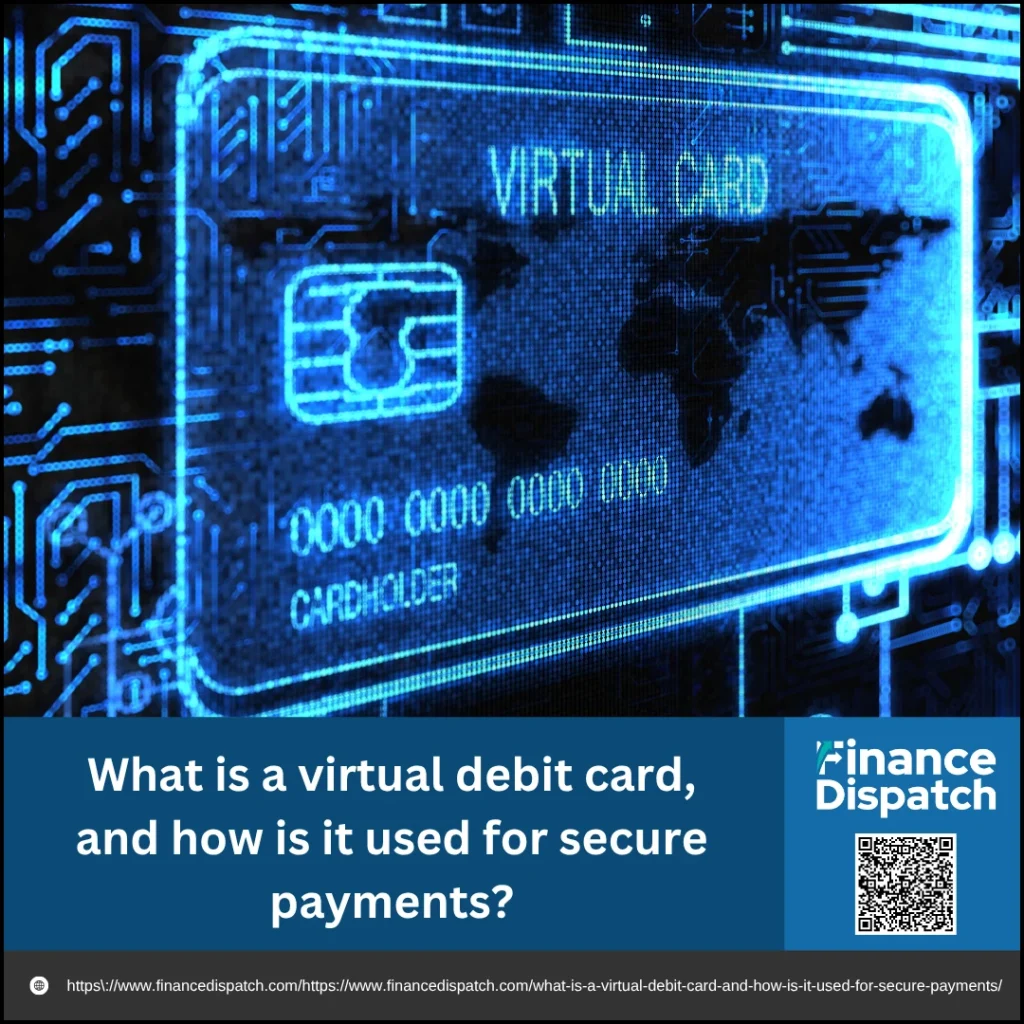In today’s fast-paced digital world, making secure and convenient online payments has become more important than ever. Whether you’re shopping online, subscribing to services, or managing business expenses, the need for a reliable payment method is undeniable. This is where virtual debit cards come in. These digital alternatives to physical debit cards are designed for online and mobile transactions, offering instant access, enhanced security, and complete control—right from your smartphone or computer. In this article, we’ll explore what virtual debit cards are and how they work to keep your payments safe and seamless.
What is a Virtual Debit Card?
A virtual debit card is a digital version of a traditional debit card that exists only in electronic form. Issued by banks or financial platforms, it comes with a unique 16-digit card number, CVV code, and expiration date—just like a physical card—but is accessed through mobile apps or online banking. Unlike physical cards, you don’t receive a plastic version; instead, you use the virtual card details to make online purchases or link it to digital wallets like Apple Pay or Google Pay for contactless in-store payments. Designed primarily for secure, cashless transactions, virtual debit cards offer a flexible and convenient way to manage your spending digitally.
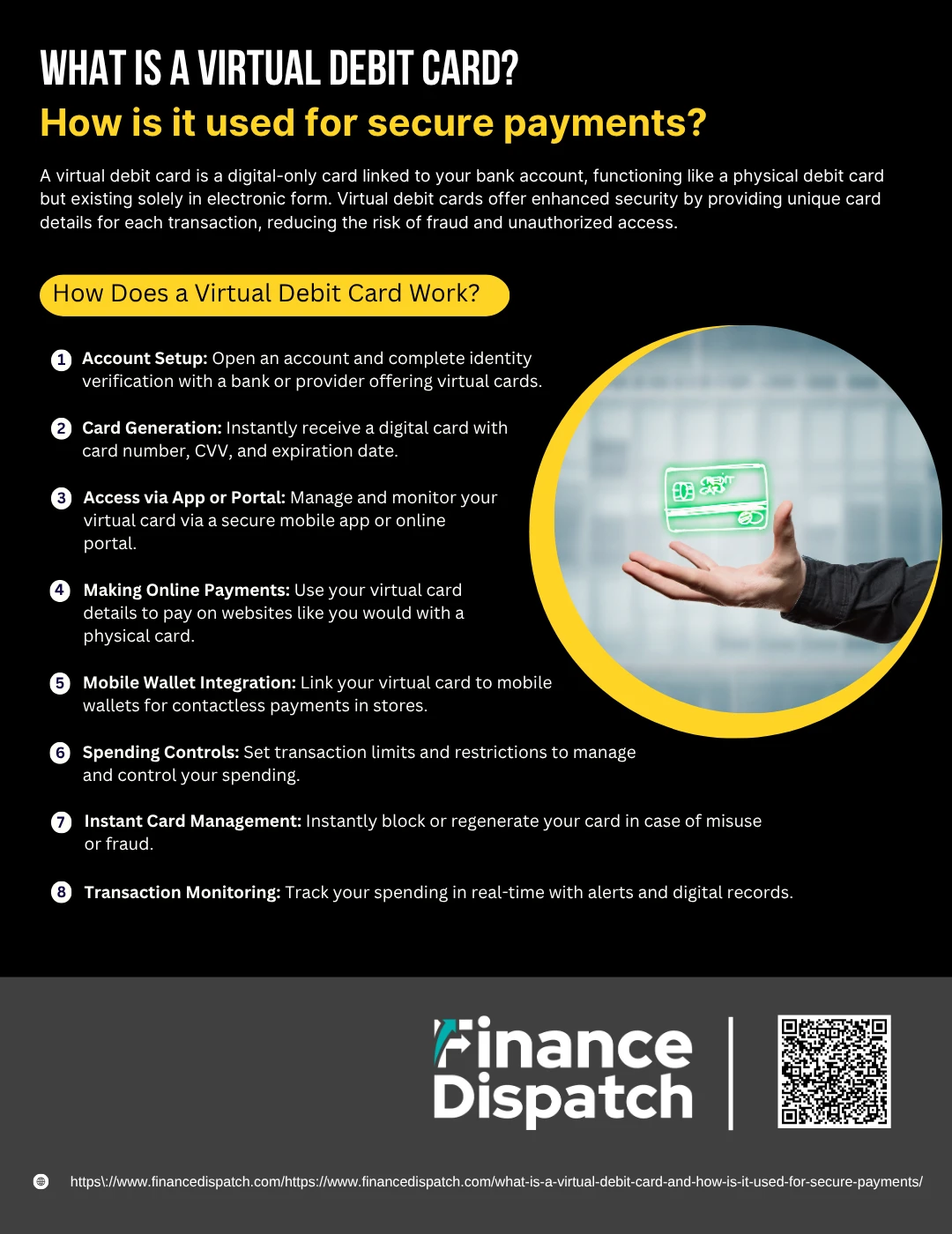 How Does a Virtual Debit Card Work?
How Does a Virtual Debit Card Work?
A virtual debit card works much like a physical debit card, but it’s entirely digital and optimized for online and mobile transactions. Once issued by your bank or financial service provider, it is linked to your existing account and can be used to make secure payments without the need for a physical card. Here’s how the process typically works:
1. Account Setup
To get started with a virtual debit card, you first need to open an account with a bank or digital financial service that offers this feature. Many banks now provide the option to apply for a virtual debit card during the account registration process—either online or through their mobile app. This setup often includes identity verification using KYC (Know Your Customer) procedures, which may involve uploading ID documents and providing contact information.
2. Card Generation
Once your account is approved, the bank or platform issues your virtual debit card almost instantly. You won’t receive a plastic card in the mail; instead, you’ll get a digital version with a 16-digit card number, CVV security code, and expiration date. These details are similar to what you’d find on a physical debit card and are sufficient for making online purchases and digital transactions.
3. Access via App or Portal
Your virtual card lives in your bank’s secure mobile app or online banking portal. From there, you can easily access your card details, view your transaction history, and manage settings. The convenience of having everything in one place means you can monitor and control your spending at any time, without needing to visit a branch or ATM.
4. Making Online Payments
To use your virtual debit card for online purchases, simply enter the card number, expiry date, and CVV at the payment gateway—just as you would with a physical card. It works seamlessly with most e-commerce platforms and service providers that accept VISA, Mastercard, or similar networks. Some providers even allow you to create single-use cards for added security on one-time transactions.
5. Mobile Wallet Integration
Virtual debit cards can be linked to popular mobile wallets like Apple Pay, Google Pay, or Samsung Pay. This enables you to make contactless payments at physical stores that accept tap-to-pay. By adding the card to your digital wallet, your smartphone becomes your new payment tool—eliminating the need to carry a physical card altogether.
6. Spending Controls
A major benefit of virtual debit cards is the ability to customize your spending. You can set daily, weekly, or monthly transaction limits and even restrict the card’s usage to certain types of merchants. These controls are especially useful for budgeting, preventing overspending, or monitoring transactions for family members, employees, or children.
7. Instant Card Management
If your virtual debit card is compromised, you can instantly block or delete it via your mobile app or banking portal. Some services also allow you to regenerate a new virtual card within minutes. This quick action significantly reduces the risk of fraud and ensures that your account remains protected, without waiting days for a replacement card.
8. Transaction Monitoring
All payments made using your virtual debit card are logged in real time. You receive instant alerts for every transaction, helping you track expenses and detect unauthorized activity. This transparency makes it easier to manage your finances and stay informed about how and where your money is being spent.
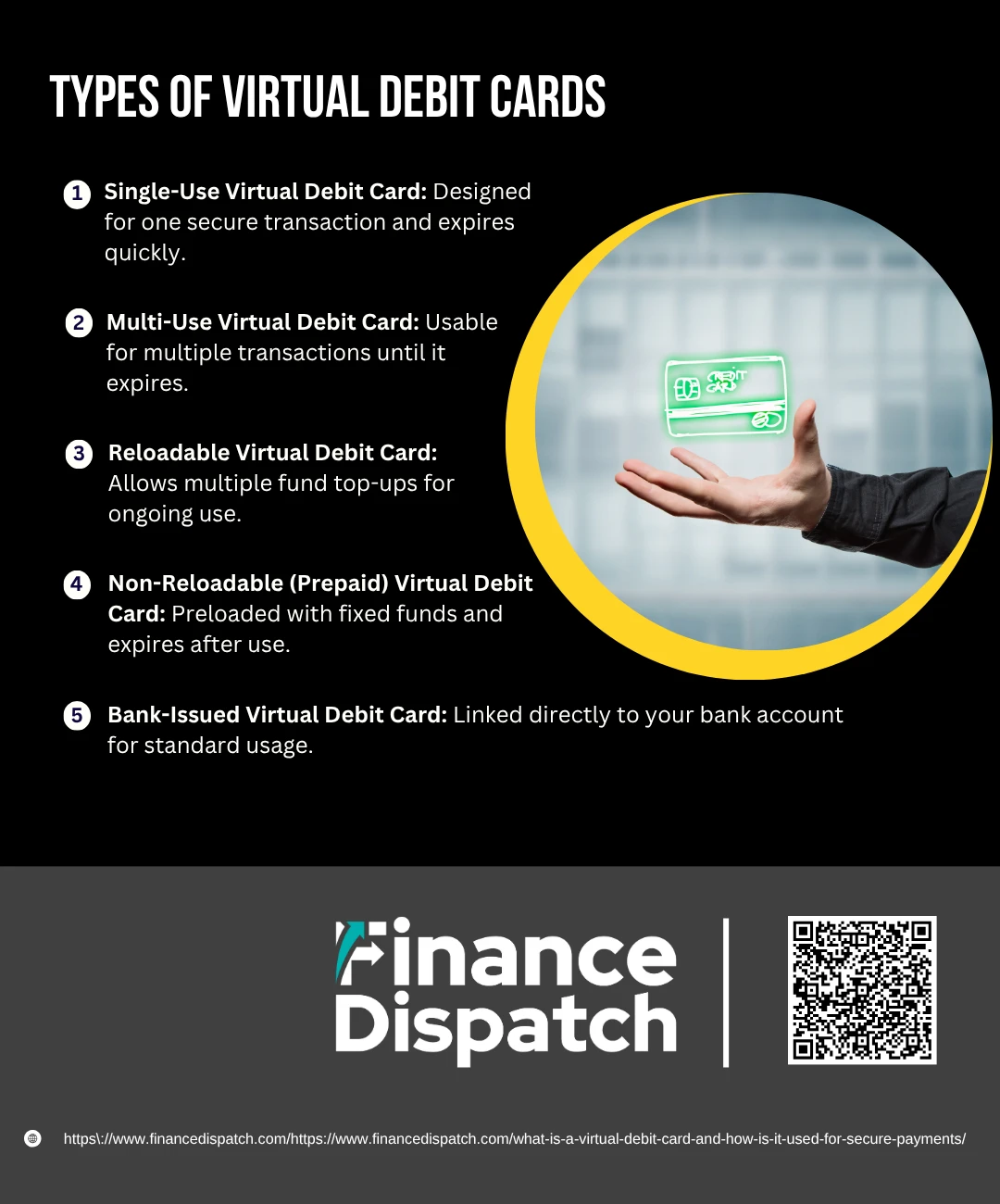 Types of Virtual Debit Cards
Types of Virtual Debit Cards
Virtual debit cards come in different types based on their usage and duration. While all virtual cards serve the core function of enabling secure online payments, their specific features can vary depending on the bank or service provider. Understanding the types available can help you choose the right one for your spending habits and security needs.
1. Single-Use Virtual Debit Card
As the name suggests, a single-use virtual debit card is designed for one-time transactions. It is automatically deactivated after the first purchase or within a short period (often 24–48 hours). This makes it ideal for high-security needs, such as shopping on unfamiliar websites or sharing card details for a single service.
2. Multi-Use Virtual Debit Card
A multi-use virtual debit card functions much like a physical debit card but exists only in digital form. You can use it for multiple transactions until its expiration date. It is suitable for recurring expenses like monthly subscriptions, online shopping, and digital services.
3. Reloadable Virtual Debit Card
Reloadable cards allow you to add funds multiple times. They are often offered by fintech companies and can be used for flexible budgeting or controlled spending, especially for teens or employees. The card remains active as long as you continue to reload it with funds.
4. Non-Reloadable (Prepaid) Virtual Debit Card
These are issued with a fixed balance and cannot be reloaded after use. Once the funds are exhausted, the card becomes invalid. Prepaid virtual cards are excellent for gifting, travel, or trial subscriptions where you want to limit financial exposure.
5. Bank-Issued Virtual Debit Card
These are directly linked to your savings or checking account and are typically available through your bank’s app or online platform. They mirror the balance of your account and offer features like transaction monitoring, spending controls, and easy card management.
Benefits of Using Virtual Debit Cards
As digital payments become more widespread, virtual debit cards are proving to be a safer and more convenient alternative to physical cards. These digital-only cards are ideal for online shopping, subscription management, and mobile wallet payments. With their advanced security features and instant accessibility, virtual debit cards offer multiple advantages for both individuals and businesses. Here are some of the key benefits:
1. Enhanced Security: Virtual cards reduce the risk of theft, cloning, and unauthorized use, as they exist only in digital form and can be easily blocked or deleted if compromised.
2. Instant Availability: You can generate and start using a virtual debit card within minutes, without waiting for physical delivery or activation through an ATM.
3. Custom Spending Limits: Users can set daily, monthly, or per-transaction limits, adding a layer of control and reducing the risk of overspending or fraud.
4. Easy Subscription Management: Assign different virtual cards for different services to track recurring payments and avoid unexpected charges.
5. No Risk of Physical Loss: Since there is no physical card to carry, there is no chance of it being lost, stolen, or damaged.
7. Support for Contactless Payments: Virtual cards can be linked to digital wallets like Apple Pay or Google Pay, enabling secure contactless payments in physical stores.
8. Environmentally Friendly: By eliminating plastic cards, virtual debit cards contribute to reducing waste and support eco-conscious financial practices.
9. Real-Time Transaction Monitoring: Receive instant alerts and monitor your spending through your mobile banking app for better budgeting and fraud prevention.
10. Ideal for Online Shopping: Virtual cards are perfect for e-commerce, allowing you to shop without exposing your primary debit card or account details.
11. Low or No Fees: Many banks and platforms offer virtual debit cards with minimal or zero annual fees, making them a cost-effective payment option.
Limitations of Virtual Debit Cards
While virtual debit cards offer numerous advantages for secure and convenient online payments, they also come with certain limitations that may affect how and where you can use them. It’s important to understand these drawbacks before relying solely on a virtual card for your transactions. Here are some of the common limitations associated with virtual debit cards:
1. Not Usable at ATMs: Most virtual debit cards do not support ATM withdrawals, which means you cannot use them to access physical cash.
2. Limited Acceptance for In-Store Purchases: Unless linked to a mobile wallet like Apple Pay or Google Pay, virtual cards may not be accepted at physical point-of-sale (POS) terminals.
3. Dependent on Technology and Internet Access: Since virtual cards are managed through apps or online platforms, you’ll need a working internet connection and a functioning smartphone or device to use them.
4. May Not Work on All Websites: Some older or less secure websites might reject virtual cards due to compatibility or security policy restrictions.
5. Expiration or Deactivation Issues: Single-use or short-term virtual cards may expire quickly, which can be inconvenient if you need to make repeat purchases or recurring payments.
6. Lack of Physical Backup: In case of emergencies, such as phone battery dying or app glitches, you won’t have a physical card to fall back on.
7. Fewer Loyalty or Reward Programs: While some virtual debit cards offer rewards, they may not be as extensive as those tied to traditional credit or debit cards.
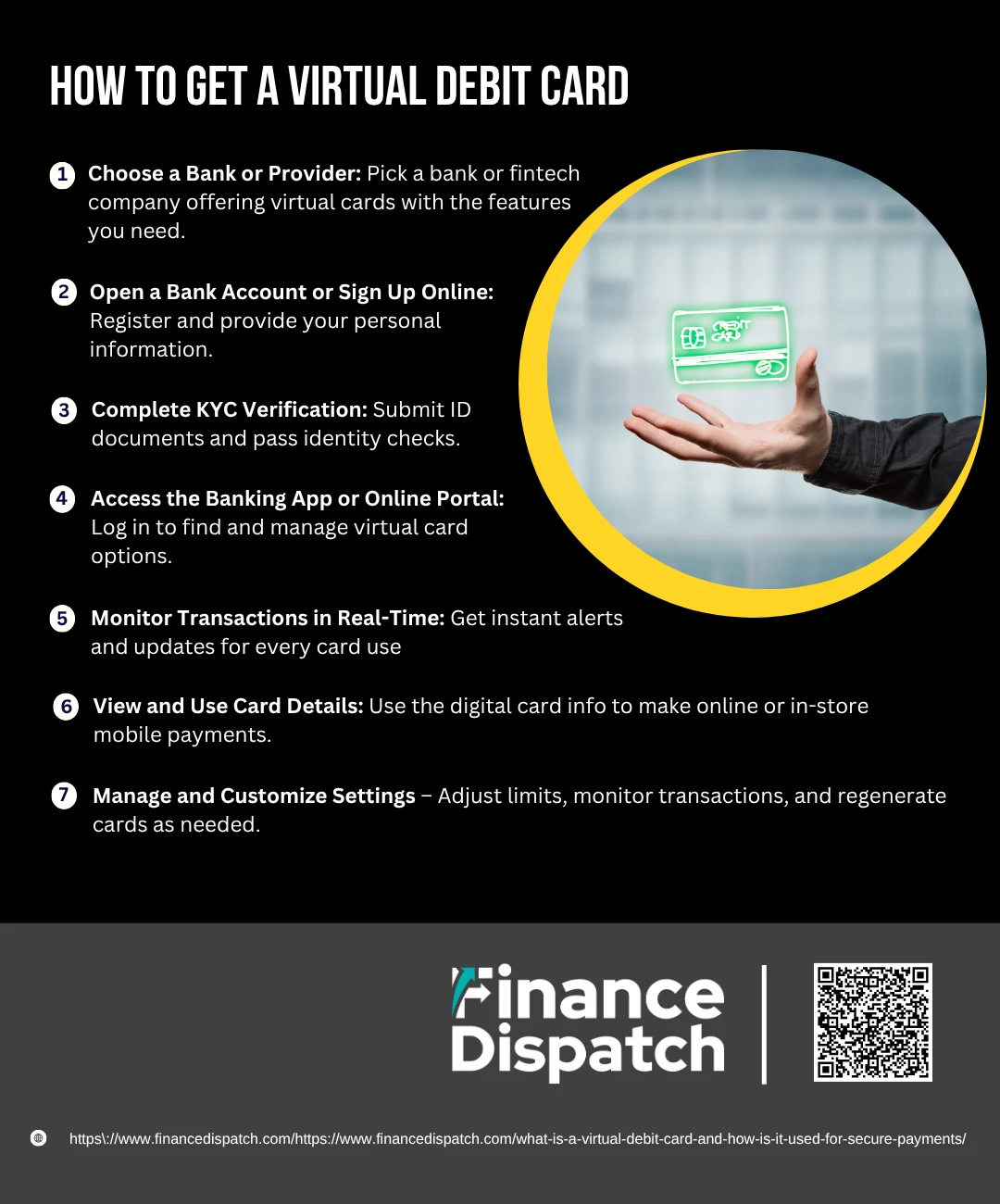 How to Get a Virtual Debit Card
How to Get a Virtual Debit Card
Virtual debit cards offer a fast, secure, and flexible alternative to traditional plastic cards. They are especially useful for online shopping, managing subscriptions, and making mobile payments—all without the risk of physical loss or theft. With most financial institutions and fintech platforms offering virtual card services, getting one is easier than ever. Below is a step-by-step guide to help you get your virtual debit card with confidence and ease:
1. Choose a Bank or Provider
Begin by researching and selecting a bank or digital payment platform that offers virtual debit cards. Look for providers that meet your requirements in terms of security features, card control options, accepted currencies, and integration with mobile wallets. Check customer reviews and compare any fees or limitations, such as transaction caps or expiration policies.
2. Open a Bank Account or Sign Up Online
If you’re not already a customer, you’ll need to open an account with your chosen provider. This can usually be done through their website or mobile app. You’ll be asked to fill in basic details like your full name, date of birth, address, phone number, and email address. Some platforms may also ask you to choose the account type—such as personal, business, or savings.
3. Complete KYC Verification
Know Your Customer (KYC) is a mandatory identity verification step required by most banks and financial institutions. You’ll need to upload identification documents like a passport, driver’s license, or national ID. Some providers may also ask for a selfie or short video to match your face with the ID photo. The verification process can take anywhere from a few minutes to a couple of days, depending on the provider.
4. Access the Banking App or Online Portal
After your account is approved and verified, log in to the provider’s online banking system or mobile app. Navigate to the “Cards” or “Payments” section, where you’ll find the option to generate a new virtual debit card. This centralized dashboard is where you’ll manage all aspects of your virtual card going forward.
5. Request and Generate the Card
Click on the button to create a new virtual debit card. You may be prompted to give the card a name, choose a currency (if supported), and set any desired limits (such as maximum daily spend). Once confirmed, your virtual card is generated instantly and ready for use. It will display the card number, expiration date, and CVV—just like a physical card, but accessible only online.
6. View and Use Card Details
With your card details available in the app, you can now use your virtual debit card to shop online, sign up for services, or make digital payments. Simply enter the card number, expiry, and CVV at the checkout screen. If you prefer in-store purchases, you can link your virtual card to Apple Pay, Google Pay, or another supported mobile wallet for contactless payments.
7. Manage and Customize Settings
Your virtual debit card gives you complete control at your fingertips. Use the app to monitor transactions in real time, adjust spending limits, freeze or delete the card instantly, or regenerate a new one if needed. Some platforms also let you create multiple virtual cards—each dedicated to specific purposes like shopping, subscriptions, or business expenses. This adds an extra layer of organization and security to your finances.
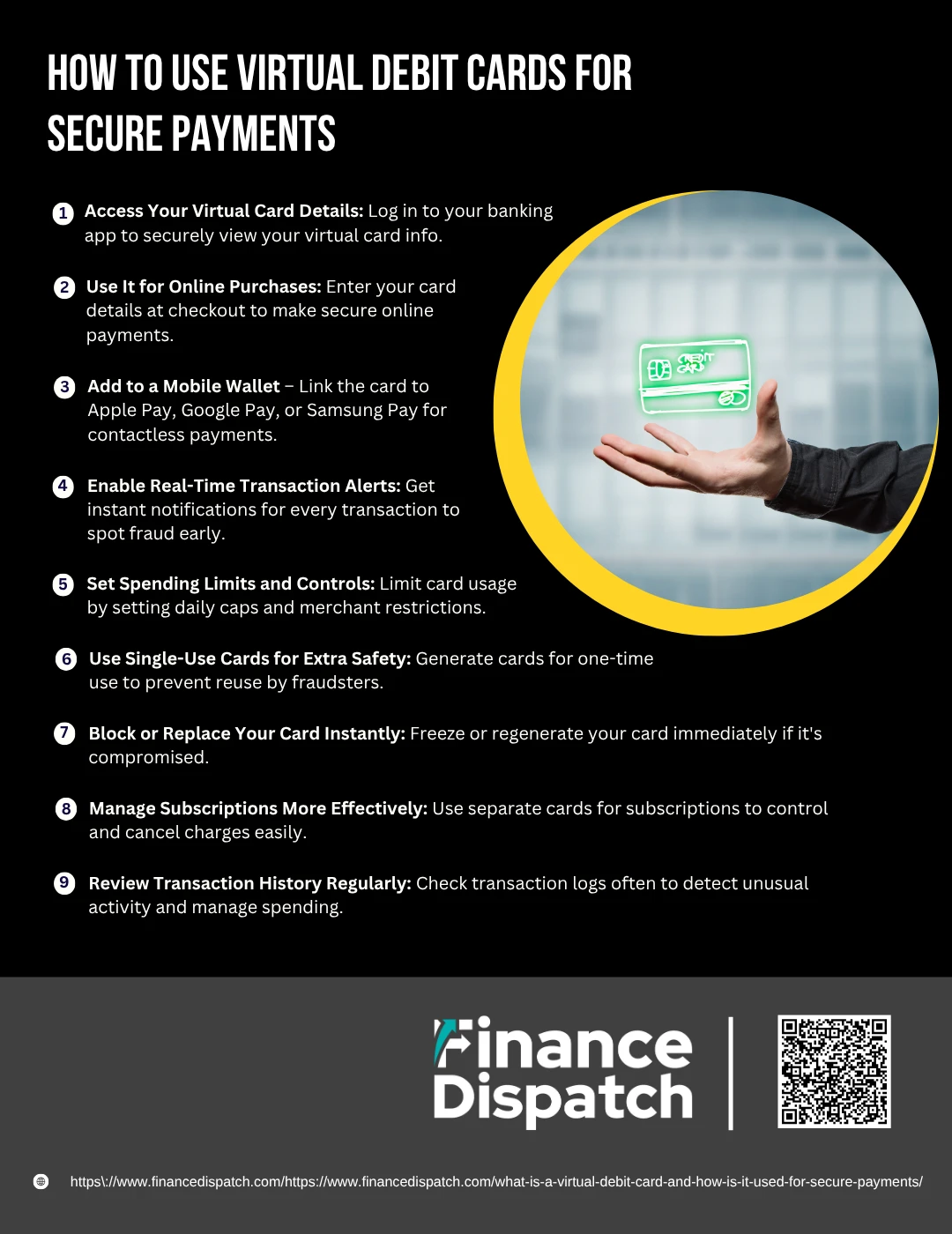 How to Use Virtual Debit Cards for secure payments?
How to Use Virtual Debit Cards for secure payments?
Virtual debit cards have become an increasingly popular choice for those seeking safer ways to make online and digital payments. Unlike physical cards, virtual debit cards exist only in digital form and are typically issued by banks or financial platforms. They can be used to pay for products, subscriptions, and services without exposing your actual bank card details. When used correctly, virtual debit cards offer a secure, fast, and flexible way to manage your spending. Here’s a step-by-step guide on how to use them safely and effectively:
1. Access Your Virtual Card Details
Log into your bank’s mobile app or online banking platform to find your virtual card information. This includes the card number, expiration date, and CVV—similar to a physical debit card, but available only through secure digital access.
2. Use It for Online Purchases
At the payment checkout page on e-commerce websites or apps, enter your virtual debit card details just like you would with a physical card. The transaction amount will be deducted from your linked bank account or card balance.
3. Add to a Mobile Wallet
For contactless payments in physical stores, link your virtual debit card to mobile wallets like Apple Pay, Google Pay, or Samsung Pay. This lets you make tap-to-pay transactions securely using your smartphone or smartwatch.
4. Enable Real-Time Transaction Alerts
Turn on notifications to receive instant alerts whenever your virtual card is used. This helps you monitor your spending and detect any unauthorized or suspicious transactions immediately.
5. Set Spending Limits and Controls
Use your banking app to set daily or monthly spending limits. You can also restrict usage to specific merchant categories. This not only helps with budgeting but also protects against large unauthorized charges.
6. Use Single-Use Cards for Extra Safety
When shopping on unfamiliar websites, consider generating a single-use virtual card. These are valid for just one transaction and automatically expire afterward, minimizing the risk of fraud or data leaks.
7. Block or Replace Your Card Instantly
If you suspect your virtual debit card has been compromised, you can freeze, block, or regenerate it instantly from your banking dashboard—no need to call customer service or wait for a new card to be delivered.
8. Manage Subscriptions More Effectively
Assign different virtual cards for various subscriptions like Netflix, Spotify, or cloud storage services. This makes it easier to track and cancel recurring payments, and prevents overcharging from forgotten services.
9. Review Transaction History Regularly
Frequently check your virtual card’s transaction history through the app. This helps you maintain awareness of your spending patterns and quickly identify any anomalies.
Are Virtual Debit Cards Secure?
Yes, virtual debit cards are considered highly secure for digital transactions. Unlike physical cards, they cannot be lost, stolen, or duplicated, as they exist only in digital form. Most virtual cards are protected by strong authentication methods such as passwords, biometric login, and one-time passwords (OTPs) during transactions. Additionally, users can set spending limits, enable real-time alerts, and instantly block or delete the card in case of suspicious activity. Some virtual cards are even designed for single use, automatically expiring after one transaction, which further minimizes the risk of fraud. These layered security features make virtual debit cards a safe and reliable option for online shopping, subscription payments, and mobile wallet transactions.
Things to Consider Before Choosing Virtual Debit Cards
While virtual debit cards offer convenience, speed, and added security, not all cards are created equal. Before selecting a virtual debit card, it’s important to evaluate several key factors to ensure it meets your personal or business needs. Understanding these considerations can help you avoid hidden fees, compatibility issues, and limitations in usage. Here are the essential things to look for:
1. Fees and Charges: Check for any hidden costs such as issuance fees, monthly maintenance charges, foreign transaction fees, or currency conversion rates.
2. Spending Limits and Controls: Ensure the provider allows you to customize spending limits, transaction caps, and merchant restrictions for better control over usage.
3. Banking and App Integration: Choose a card that integrates smoothly with your banking system or mobile wallet (Apple Pay, Google Pay), especially if you want seamless access and payments.
4. Security Features: Look for strong security protocols like OTP verification, instant card blocking, real-time alerts, and biometric login to protect against fraud.
5. Card Usage Flexibility: Confirm whether the virtual card supports single-use, recurring payments, or multiple currencies, depending on your transaction needs.
6. Customer Support: Reliable and accessible customer service is essential in case you encounter issues with activation, transactions, or fraud.
7. Subscription Management Tools: If you use many online services, opt for cards that let you manage and organize subscriptions efficiently to avoid accidental renewals.
8. Accepted Payment Network: Ensure the card runs on widely accepted networks like Visa or Mastercard to guarantee broader usability across merchants.
9. Card Expiry and Renewal Policies: Understand the validity period of the virtual card and whether you can easily regenerate or extend it when needed.
Conclusion
Virtual debit cards are a modern solution for secure and efficient digital payments. They offer numerous advantages, including enhanced security, instant availability, and easy management through mobile apps. Whether you’re shopping online, managing subscriptions, or making contactless payments, virtual debit cards provide the flexibility and control needed in today’s digital world. While they come with certain limitations, such as restricted ATM use and reliance on internet access, their benefits often outweigh the drawbacks. By choosing the right provider and using your card wisely, you can enjoy a safer and more convenient way to manage your finances.



